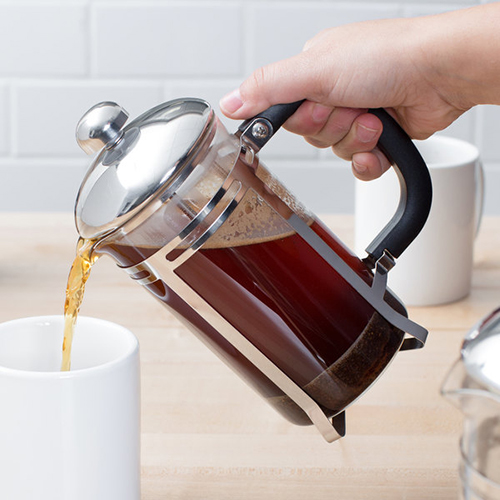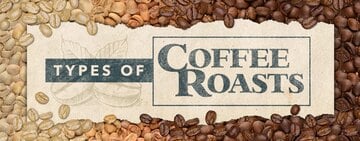
French press coffee is becoming one of the most popular coffee brewing methods in the food service industry. Coffee brewed in a French press offers bold flavors that guests at coffee shops, cafes, and restaurants have come to love. Learn more about this brewing style and follow our French press brewing instructions to extract your coffee beans like an expert.
Shop All French PressesHow to Use a French Press Video
Check out this video for a visual guide to making coffee in a French press:
How to Make French Press Coffee
Creating your own French pressed coffee is an uncomplicated process that can improve your restaurant’s coffee service and reward you with flavorful coffee.
French Press Coffee Ingredients and Supplies
To make French press coffee, you’ll need:
- Coarse ground coffee beans
- Hot water between 190 and 200 degrees Fahrenheit. This can be achieved by allowing the water to come to a boil, removing it from the heat source, and letting it sit for a minute or two before use.
- French press
- Portion scale to measure ingredients
How to Make Coffee in a French Press: Step-by-Step

Follow these step-by-step instructions to make coffee in a French press:
- Preheat French press: Add hot water to your French press and swirl it around to warm up the device before use. This will reduce temperature shock to your beans and keep your coffee hotter for longer.
- Remove water and dry: After about a minute, dump out the water from the canister and dry your press.
- Add coffee beans: Measure out your ground coffee beans and add them to the canister. 2 Tbsp. (28.3 grams) of coffee is used per 1 cup of water.
- Soak the grounds: Add just enough boiling water to cover and soak the grounds.
- Stir the grounds and let them sit: Stir the grounds, attach the lid, and allow the mixture to sit for about 30 seconds.
- Add remaining water: Remove the lid and add the remaining water to the canister. Give the mixture a gentle stir.
- Attach the lid: Attach the lid and make sure the plunger is pulled up. This allows the screen to sit flush against the bottom of the lid, which prevents steam from escaping.
- Steep: Allow the coffee to steep for 3 to 5 minutes, depending on how finely ground the beans are.
- Push the plunger down: After 3-5 minutes, hold the top of the lid down with one hand and slowly push down the plunger with the other hand. This should take about 20 seconds, and there will be some resistance.
- Pour coffee: Pour the coffee into a coffee decanter or coffee cup immediately. Because of the direct immersion between the water and the beans, the longer you let the coffee sit in the French press, the more bitter it becomes.
French Press Brew Guide
Once you master the basics of making coffee in a French press, you’re ready to perfect your coffee craft. Use our French press brew guide to produce the perfect cup of French press coffee. We answer some common questions about French press coffee below.
French Press Coffee Ratio
If you’re wondering how much coffee you need for your French press, you must first decide whether you want a mild, regular, or strong brew. For a mild French press brew, measure out a 1:17 ratio of coffee to water. For a regular French press brew, measure out a 1:15 coffee to water ratio. For a strong French press brew, measure out a 1:12 coffee to water ratio.
Because a French press is an immersion brewer, the water is saturated with coffee throughout the brewing cycle, requiring more coffee beans and an extended extraction period. For the best tasting French press coffee, use a portion scale to measure your coffee and water ratios. The French press brewing style requires more coffee than other methods.
French Press Grind Size
A French press requires coarse coffee grounds. For an even extraction, the coarse grounds will need to be even in size.
How Long to Brew French Press

On average, French Press coffee takes four minutes to brew. If your water is on the cooler side, you can extend the brew time to five minutes.
What Is a French Press?
A French press coffee maker is a cylindrical pot with a plunger and built-in filter used to brew ground coffee beans. The French press keeps the coffee grounds in contact with the water throughout the entire brewing period and “presses” hot water through the ground coffee.
A French press filters the brew through its built-in metal screen, which means the essential oils found in the grounds are not absorbed by filters or evaporated. Instead, they remain in the brew and result in a stronger, richer coffee with a more aromatic flavor. This method is known as direct immersion brewing. Because more of the coffee beans' flavor infuses into each cup, pressed coffee is the perfect brewing method for savoring single-origin coffee beans.
How Hot Should Water Be for French Press?
You should heat the water for your French press to 195 degrees Fahrenheit. While less precise, you can bring the water to a boil and then rest it for 30 seconds before pouring it over your coffee grounds and starting the brewing process.
Drip Coffee vs. French Press
Drip coffee from traditional commercial coffee machines filters coffee grounds through coffee filters, yielding milder coffee compared to French presses. Most drip coffee machines employ automatic brewing, produce large volumes of coffee, and keep the coffee warm for extended periods. French presses produce a smaller amount of stronger-tasting coffee intended for immediate consumption.
When purchasing coffee shop equipment, you'll require a mix of tools and machines to meet a variety of coffee drinking needs. Before choosing your coffee, roasts, and creating your menu, you should understand which establishments benefit from a coffee press vs. a coffee maker.
- Settings that Benefit from Drip Coffee: diners, office break rooms, and cafeterias
- Settings that Benefit from French Press Coffee: small cafes, coffee shops, and bakeries
What Are the Best Coffee Beans for a French Press?
You’ll always want to grind whole coffee beans when using a French press because pre-ground beans are too fine for direct immersion brewing.
Because the coffee beans remain in contact with the water during the entire steeping process, you’ll want to grind your beans to a coarser consistency than you would for an espresso maker or automatic drip brewer. The fast infusion rate of French press brewing means finely ground beans will produce a bitter taste.
Back to TopHow to Choose a French Press

When choosing a French press, you’ll want to consider two factors: materials and size. We break down what you should be looking for when you choose a French press below.
How to Choose French Press Materials
The three main components of a French press are its carafe, plunger, and lid. There are other small parts and pieces, but the quality of the plunger, carafe and lid determine the quality of the French Press. We explain what you evaluate for each of these three parts below.
How to Choose a French Press Plunger
The plunger piece includes a handle and a filter. When you push the plunger’s handle down, it forces the filter down which in turn pushes the coffee grounds to the bottom of your French press carafe. You can determine the quality of a plunger by its filter. Avoid filters with plastic edges. They will erode after repeated use and are not dishwasher safe. Over time, plastic carafes allow coffee grounds to slip into the brewed coffee, soiling your final product. Choose a filter with durable metal edges. Your metal filter will remain intact unless it is bent, preserving your investment and reducing replacement costs.
How to Choose a French Press Carafe
- Stainless Steel Carafe - If you’re brewing your French press coffee in your kitchen, a stainless-steel carafe is your best option. Stainless steel carafes neither break nor interfere with the brewing process. The only drawback of a stainless steel carafe is you cannot watch the brewing process. However, if the customer will never see the French Press, this is a non-issue.
- Tempered Glass Carafes - If you’re going to display the carafe to the customer and want to create a premium cup of French press coffee, then tempered glass carafes are ideal for your operation. Tempered glass doesn’t interfere with the brewing process and provides a beautiful window for the patron to watch their coffee brew through. However, tempered glass is prone to breakage, making it unideal in high-volume establishments where accidents are more likely to occur.
- Plastic Carafes - If you operate a bustling establishment in a small space and want to display your French press to customers, then a plastic carafe is ideal for you. Plastic carafes allow you to view the brewing process but do not break. However, plastic interferes with the brewing process and will not produce the highest quality product. Weigh the potential breakage of a glass carafe and the lack of aesthetic appeal of a tempered glass carafe against this quality loss and decide what is best for you.
How to Choose French Press Top Piece
Look for a French press top piece with a guard. The guard prevents heat from escaping through the carafe spout while your coffee brews. Most top pieces with guards twist on and off, removing the air barrier and allowing you to pour your extracted coffee.
How to Choose a French Press Size
You’ll need to determine how much coffee you want your French press to make at one time. 3, 8, and 12 cup French presses are the most common. In ounces, a French press cup yields 4 ounces of brewed coffee.
- 3 Cup French Press - produces 12 ounces of brewed coffee
- 8 Cup French Press - produces 32 ounces of brewed coffee
- 12 Cup French Press - produces 48 ounces of brewed coffee
While a French press may require more attention than your automatic brewer, the outcome is an aromatic cup of coffee your customers will savor. Serve it hot or bring bold flavors to your selection of iced coffees. No matter how you serve it, this easy, trendy brewing method is sure to put your restaurant or cafe’s coffee service on the map.





